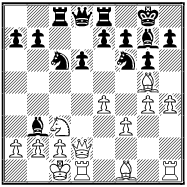Well, I just saw that Chess Cafe posted a review, and reading it got me all excited about the book. I will be posting impressions as I go through it, but since I am just getting into it, I will quote a piece of the review for now. I chose the following partly because of the recent discussions on BDK's blog (and other places) about Watson vs. Aagaard, rule independence etc:
Chapter 7 (“The Concrete Approach”) is only seven pages long, but it may be one of the most important sections of the book. Lipnitsky demonstrates how dogmatic adherence to general principles can lead a player to defeat without his realization of what actually happened. “In any particular position,” he states, “the rejection of some laws (directives) merely makes way for the affirmation and success of others.” A player must be able to accurately assess, Lipnitsky states, “which laws – maxims, principles, rules – are valid in a given, specific case.” Here’s an excellent example, a practical case faced frequently:Thank you Chess Cafe for this detailed review. I am really looking forward to sinking my teeth into this classic and posting my own impressions. Stay tuned!
It is White to move, and Lipnitsky addresses two opposite approaches regarding how White should capture the bishop on b3:
(a) The superficial, dogmatic decision: White must capture towards the centre with a2xb3, since c2xb3? would open up the king, which is on the same file as the black rook. Besides, after c2xb3? Black would be left with an easily won king-and-pawn endgame if all the pieces were exchanged. Therefore, a2xb3!.
(b) The concrete, creative decision: in this position the chief, determining principle is the all-out attack on opposite wings. In the event of 13.axb3? Nb4!, threatening Qd8-a5, Black obtains an extremely strong attack. On the other hand after 13.cxb3! Black’s attack is very hard to develop, despite the placing of the rook and king opposite each other (For example: 13…Nb4 14.Kb1!).
White for his part will be able to continue his successful storming of the opponent’s kingside. In these circumstances Black’s extra pawn in the centre has no special significance.
8 comments:
Stays tuned for the impression.
Who knows, if i like the impressions i might buy the book although i have already to many dustcollectors on my shelf already.
So read a bit quicker. Make a little text of what you read and post it already, darned! ;-)
hahaha that's funny chesstiger :) ok I will try to get on with it as quickly as possible sir!
I've been wondering for quite some time now as i still did not have the chance to take a peek in it in a chess book store. Is it an opening book or what? Could you maybe give a summary of the contents?
CMoB: It's not an opening book. It covers a lot of ground, from opening principles to middlegame strategy to evaluation and more, all with very hands-on examples and games (see example in my post). At this point, I can't really make a statement as to how good the book is, as I am just starting to work through it. Here is the table of contents:
Ch. 1 On the Opening
Ch. 2 The Centre
Ch. 3 The Centre and the Flanks
Ch. 4 Conquering the Centre from the Flanks
Ch. 5 Mobilizing the Pieces
Ch. 6 Evaluating the Position
Ch. 7 The Concrete Approach
Ch. 8 From Critical Positions to Settled Positions
Ch. 9 Positional Flair
Ch. 10 Plans in the Opening
Ch. 11 The Initiative
Ch. 12 Modern Gambits
Ch. 13 Opening and Middlegame
Ch. 14 Reevaluation of Values
Ch. 15 How Long Does a “Novelty” Last?
Ch. 16 How is an Innovation Born?
As you can see, it discusses a lot of different topics. It was written in the 1950's and I read somewhere that it is the missing link between Nimzowitsch's earlier "My System" and today's chess. That description seems appropriate, and the writing style and presentation of topics do remind me of Nimzowitsch's book.
Neat example--look forward to more of your impressions on the book.
Given the table of contents it sounds like a great book. It was allready on my "books i wonna have" list, especially since it is presumed to be the reason why Bobby Fischer learned to read russian (though that's probably a sales catch). And i'm a big fan of Fischer. I was just hoping it wasn't an opening book. An idea i got somewhere that said Fischer also read it because it covered particular Sicilian variations. And i wasn't interested in another opening book. Even if Fischer read it.
I noticed in that review last week that he had a bit on concrete chess with reference to rule following. I bet that's a theme that goes back to Steinitz at least!
Who knows where to download XRumer 5.0 Palladium?
Help, please. All recommend this program to effectively advertise on the Internet, this is the best program!
Post a Comment